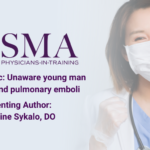Abstract | May 6, 2021
Happy Hypoxic: unaware young man with DVTs and pulmonary emboli
Intro:
COVID-19, is a multi-systemic disease, which was announced to be a pandemic by the WHO within three months of the first reported case. It was initially characterized as a respiratory virus; however, hypercoagulability and development of strokes and deep vein thrombosis (DVTs) have also been seen. We present a case of a young patient with no past medical history who developed minimally symptomatic bilateral DVTs and pulmonary emboli (PE).
Case:
A 26 year old male with no know past medical history, presented with complaints of cough, fever, and diarrhea. Per patient, his symptoms started two weeks prior to presentation, and tested negative on COVID nasal swab within that time frame. His cough was improving; however, he began developing vomiting after meals two days prior to his admission. Patient decided to come to the ED because of inability to keep food down. Additionally, he reported bilateral mid-calf pain with ambulation for three days prior to admission, and denied any shortness of breath. Family history was unremarkable, and social history was notable for binge drinking. Admission vital signs were within normal limits, except for a fever of 38.1 C and oxygen saturation of 91% on room air. Notable aspects of physical exam were that patient had no increase in work of breathing, but did have fine inspiratory crackles at the bilateral bases. Musculoskeletal exam revealed cold feet and tenderness to palpation to midline calves bilaterally, without edema or erythema. Labs were positive for D-dimer > 4, and elevated inflammatory markers. A duplex ultrasound of the lower extremities showed thrombosis of the bilateral posterior tibial veins and left peroneal vein. Pulmonary CTA showed bilateral pulmonary emboli with numerous filling defects in the pulmonary arteries, along with peripheral interstitial densities.
Diagnosis:
COVID nasal swab PCR was negative, but the IgG serum antibody was positive.
Management:
Patient was started on a heparin drip, and received IV dexamethasone for four days. Patient received one day of Remdisivir, which was then stopped, due to significant improvement. Patient was weaned off supplemental oxygen, and discharged on apixaban and additional six days of 4 mg oral dexamethasone.
Learning Objectives:
We would like to raise awareness of the effects it can have on seemingly healthy and young individuals, and recommend having a high index of suspicion of PE in patients with acute hypoxic respiratory failure, even if they lack other classic symptoms. Additionally, we ask all providers to address alcohol abuse with their patients, and have open discussions about mental health during the pandemic. Finally, we encourage use of evidence based medicine, and following treatment guidelines that are being developed and updated by the Infectious Disease Society of America, in concordance with new research.

